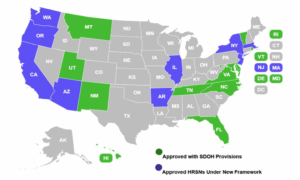With proposed cuts to SNAP of $230 billion over the next ten years looming, the Food Research and Action Center yesterday lined up speakers who put forth several powerful arguments against the measure, highlighting its potential impact on children and the economy.
The proposed cuts, which would be the largest in the program’s history, would amount to a 20% reduction in total SNAP funding. With lawmakers already preparing to advance the bill to the floor, anti-hunger advocates are scrambling to line up their opposition.
A big line of defense has to do with children. Because of their need for proper nutrition to grow, children run a greater risk of poor health and developmental delays if the SNAP cuts occur, according to Dr. Diana Cutts, MD, Chief of Pediatrics at Hennepin County Medical Center in Minnesota and Co-Lead Principal Investigator for Children’s HealthWatch.
Noting that SNAP’s role in supporting health begins even before birth, Dr. Cutts relayed a litany of potential poor outcomes that the SNAP cuts could bring about:
- More complications of pregnancy
- Smaller and sicker newborns
- More frequent and serious infections in babies and newborns
- More pediatric hospitalizations
- Increased risks of developmental delays and behavioral issues
- Increased risk of mental health concerns
Dr. Cutts’ concerns are backed by research from Children’s Health Watch, which found that families whose SNAP benefits were cut off or reduced were 43% more likely to have a caregiver in fair or poor health; 22% more likely to have a child in fair or poor health, and 28% more likely to have a child at developmental risk.
All of these medical conditions carry economic impact, including more healthcare, longer hospital stays, and higher educational costs. In a 2014 study, Children’s Health Watch conservatively estimated that food insecurity cost the U.S. economy over $160 billion annually in excess healthcare expenditures and nearly $180 billion when special education costs were added in. “In 2025, of course, those costs are much higher, and the additional strain on our current healthcare systems will impact every person’s healthcare access and quality,” Dr. Cutts said.
Further, Dr. Cutts pointed out that children do not live in isolation. Their food insecurity often means that adults in the household are living with even more severe food deprivation, resulting in less ability to function well in their roles of responsibility. “Parental well-being is a fundamental determinant of a child’s well-being and their future,” Dr. Cutts said. “I say that the proposed cuts to SNAP are a direct threat to the health and development of millions of children – one in four across our nation – and the stability of their families.”
Aside from the healthcare implications, there are economic impacts from SNAP cuts. Speaking on the FRAC call, Julia Landcastle, Coordinator of Political and Government Relations at the National Grocers Association, noted that SNAP purchases make up 12% of the nation’s grocery sales. For some independent grocers, SNAP purchases represent the majority of sales, she said.
In 2020, SNAP supported nearly 200,000 jobs in the independent grocery industry and another 45,000 jobs in related industries like agriculture, manufacturing and transportation. In addition, SNAP generated about $16 billion in wages, with about $6.7 billion of that going toward grocery-store employees and $9.4 billion to workers in supporting industries. Even though SNAP purchases aren’t taxed, they still generate tax revenue, contributing nearly $1 billion in federal tax revenue and nearly $975 million in state and local taxes.
Importantly, Landcastle noted that the statistics she shared account only for independent grocers, which represent only one-third of the entire grocery industry. (More on the impact of community grocers on economic activity can be found here.) “There’s still another two-thirds of the grocery industry that’s going to be impacted by these SNAP cuts,” she said.
“We know that reduced benefits are going to reduce consumer spending,” Landcastle said. SNAP, meanwhile, “helps families to eat, creates jobs in the communities, and in turn, helps with food insecurity and the long-term health costs of many rural towns.” – Chris Costanzo
Like what you’re reading?
Support Food Bank News








